
Green lacewings are insects in the large family Chrysopidae of the order Neuroptera. There are about 85 genera and 1,300–2,000 species in this widespread group. Members of the genera Chrysopa and Chrysoperla are very common in North America and Europe; they are very similar and many of their species have been moved from one genus to the other time and again, and in the nonscientific literature assignment to Chrysopa and Chrysoperla can rarely be relied upon. Since they are the most familiar neuropterans to many people, they are often simply called "lacewings". Since most of the diversity of Neuroptera are properly referred to as some sort of "lacewing", common lacewings is preferable.
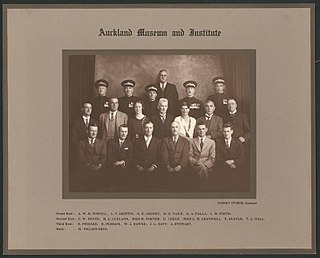
Arthur William Baden Powell was a New Zealand malacologist, naturalist and palaeontologist, a major influence in the study and classification of New Zealand molluscs through much of the 20th century. He was known to his friends and family by his third name, "Baden".

Chrysoperla is a genus of common green lacewings in the neuropteran family Chrysopidae. Therein they belong to the Chrysopini, the largest tribe of subfamily Chrysopinae. Their larvae are predatory and feed on aphids, and members of this genus have been used in biological pest control.

Chrysopinae is the nominate subfamily of green lacewings in the insect family Chrysopidae in the order Neuroptera. This subfamily is also the largest within the family and comprises about 60 genera.

Chrysopa is a genus of green lacewings in the neuropteran family Chrysopidae.

Chrysoperla carnea, one of the species of common green lacewing, is an insect in the Chrysopidae family. Although the adults feed on nectar, pollen and aphid honeydew, the larvae are active predators and feed on aphids and other small insects. It has been used in the biological control of insect pests on crops.

Chrysopini is a tribe of green lacewings in the family Chrysopidae. There are about 32 genera and 926 described species in Chrysopini.
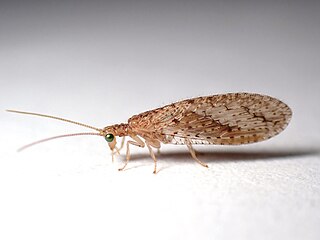
Micromus tasmaniae, known as the Tasmanian brown lacewing, is a species of brown lacewing in the family Hemerobiidae. It is widespread in Australia, New Zealand, and Pacific Islands such as New Caledonia and Vanuatu.
Sympherobius californicus is a species of brown lacewing in the family Hemerobiidae. It is found in Central America, North America, and Oceania. The species was introduced to New Zealand to prey on aphids and mealybugs affecting crops, first noted in 1936, however was not able to be established.
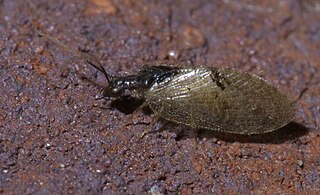
Sympherobius barberi, or Barber's brown lacewing, is a species of brown lacewing in the family Hemerobiidae. It is found in Europe and Northern Asia, Central America, North America, Oceania, and South America. The species was introduced to New Zealand to prey on aphids and mealybugs, first noted in 1936, however was not able to be established.

Chrysopa oculata is a species of green lacewing in the family Chrysopidae. It is found in North America and Central America. This species was imported to New Zealand in 1926, as a way to control aphid populations, however did not establish in the country.
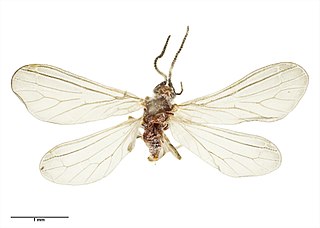
Cryptoscenea australiensis is a species of lacewing in the subfamily aleuropteryginae, first described by Günther Enderlein in 1906. No subspecies are listed in the Catalog of Life. The species is present in Eastern Australia, Tasmania and New Zealand, including the Kermadec Islands.

Drepanacra binocula, known as the Australian variable lacewing, is a species of brown lacewing in the family Hemerobiidae, found across Australia and New Zealand, including Lord Howe Island, Norfolk Island and the Kermadec Islands.

Micromus bifasciatus, is a species of Australasian brown lacewing in the family Hemerobiidae that was first described by Robert John Tillyard in 1923.

Protobiella zelandica is a species of New Zealand beaded lacewing in the family Berothidae that was first described by Robert John Tillyard in 1923. It is the sole known species in the genus Protobiella, and the only berothid endemic to New Zealand. No subspecies are noted in the Catalogue of Life.
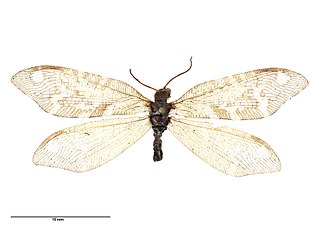
Euosmylus stellae is an endemic species of New Zealand lacewing that was first described by Robert McLachlan in 1899. It is the only species in the genus Euosmylus. The species ranges from the North Island Volcanic Plateau to the middle of the South Island, including Arthur's Pass and the Ashley Gorge. It was named in honour of George Hudson's daughter Stella.

Heteroconis ornata is a species of Australian lacewing that was first described by Günther Enderlein in 1905. The species is found in Queensland and New South Wales. The species was first recorded in New Zealand in 1988, and by the late 1980s a small colony was found to be established in West Auckland.

Gyrinus convexiusculus is a species of whirligig beetle in the family Gyrinidae, first described by Macleay in 1871.

Mallada is a genus of lacewings belonging to the family Chrysopidae. The species of this genus are found in Africa, Southeastern Asia and Australia. The genus was first described by Longinos Navas in 1925, and by monotypy the type species is Mallada stigmatus.


















